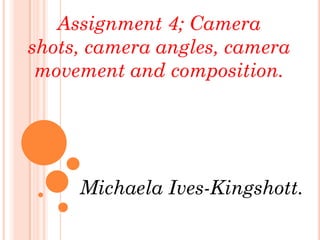
Assignemtn 4
- 1. Assignment 4; Camera shots, camera angles, camera movement and composition. Michaela Ives-Kingshott.
- 2. Camera Angle. • High. • Low. • Canted or Oblique.
- 3. High Angle. An angle which has been taken from a higher place that looks down on a character or object , this type of shot is often used to make the character or object look smaller, venerable or weak.
- 4. Low Angle. An angle that is taken from a lower place that looks up on a character or a subject, it is often used to make the character or subject look bigger, more dominant or more powerful.
- 5. Camera Shots. • Establishing shots. • Wide Shot. • Long Shot. • Mid/ Medium Shot. • Close Up Shot. • Extreme Close Up Shot. • Point Of View. • Over The Shoulder Shot. • Two Shot. • Arial Shot. • Over The Head Shot.
- 6. Establishing Shot. Establishes a setting or scene, often giving the viewer information about where a scene is set. It can be from a range of distances from wide/long shots of whole cities or wide shots of a place in a city or a house or even a close up of a sign. Establishing shots are normally at the beginning of a scene to give clarity to the audience of the setting.
- 7. Wide Shot. This shot is wide and shows a large variety of information, like a panoramic photograph. Often establishing shots are wide shots. Wide shots could be used to show everyone within a room or at a dinner table.
- 8. Long Shot. The framing of an object or character containing thier whole body or frame.
- 9. Mid Shot. Framing of a character or subject of their torso (mostly torso and head but can also be torso and legs).
- 10. Close Up Shot. Framing of a character or object or some particular part of their body of object such as face, hand or details of an object such as a fork.
- 11. Extreme Close Up Shot. A shot that is of a part of the body or face to show extreme detail to the audience to give them more information or detail about that particular character or object.
- 12. Over The Shoulder Shot. A shot which is filmed as if its from the back of the characters shoulder. The character facing the subject usually occupies 1/3 of the frame but it could vary depending on purpose. For example if the shot is to show the character facing the audience is very inferior perhaps they would only occupy ¼ of the overall shot.
- 13. Two Shot. Is of two characters communicating, interacting or conversing. Usually used to signify or show a relationship between the two characters.
- 14. Camera Movement. • Pan. • Tilt. • Tracking. • Zooming. • Slow Zoom. • Fast Zoom. • Reverse Zoom. • Dolly. • Crone. • Stedicam. • Vertigo.
- 15. Pan. When a camera pivots horizontally from left to right or right to left to reveal more information of the scene, it can be used to give a viewer a panoramic view. It is sometimes used to establish a scene that is unable to fit in one shot or frame. EXAMPLE OF PAN.
- 16. Tilt. The opposite of pan, this is when the camera pivots vertically either from the top to bottom or bottom to top to reveal more information about the setting or scene. This is often used to show the audience a character’s complete costume.
- 17. Tracking. Movement of the camera from side to side without a pivot to follow an object or character. This can include smooth movements from side to side, frontwards, backwards or even a curve but cannot include complex movement around a subject. EXAMPLE OF TRACKING.
- 18. Zoom. Zoom is when a camera feature goes in towards an object or character to reveal a more significant sense of detail. The speed of zooming can vary and be altered.
- 19. Reverse Zoom. This is the opposite to zoom, often referred to as ‘zooming out’, this is when the camera feature zooms out from an object or character to reveal more details.
- 20. Composition. • Balance. • Symmetry. • Unsymmetrical. • Rule of Thirds. • Depth Of Field. • Shallow Focus. • Deep Focus
- 21. Depth Of Field. Depth of field is the distance of what is within focus, it is the distance between the nearest object and the furthest object in a scene that appear acceptably sharp within an image.
- 22. Shallow Focus. Shallow focus is when one plane of an object is in focus while the rest is out of focus. Shallow focus is typically used to emphasize one part of the image compared to another.
- 23. Balance. Balance is arranging elements in a scene so that no part of a work overpowers, or seems heavier than any other part. The three different kinds of balance are symmetrical, asymmetrical and radical.